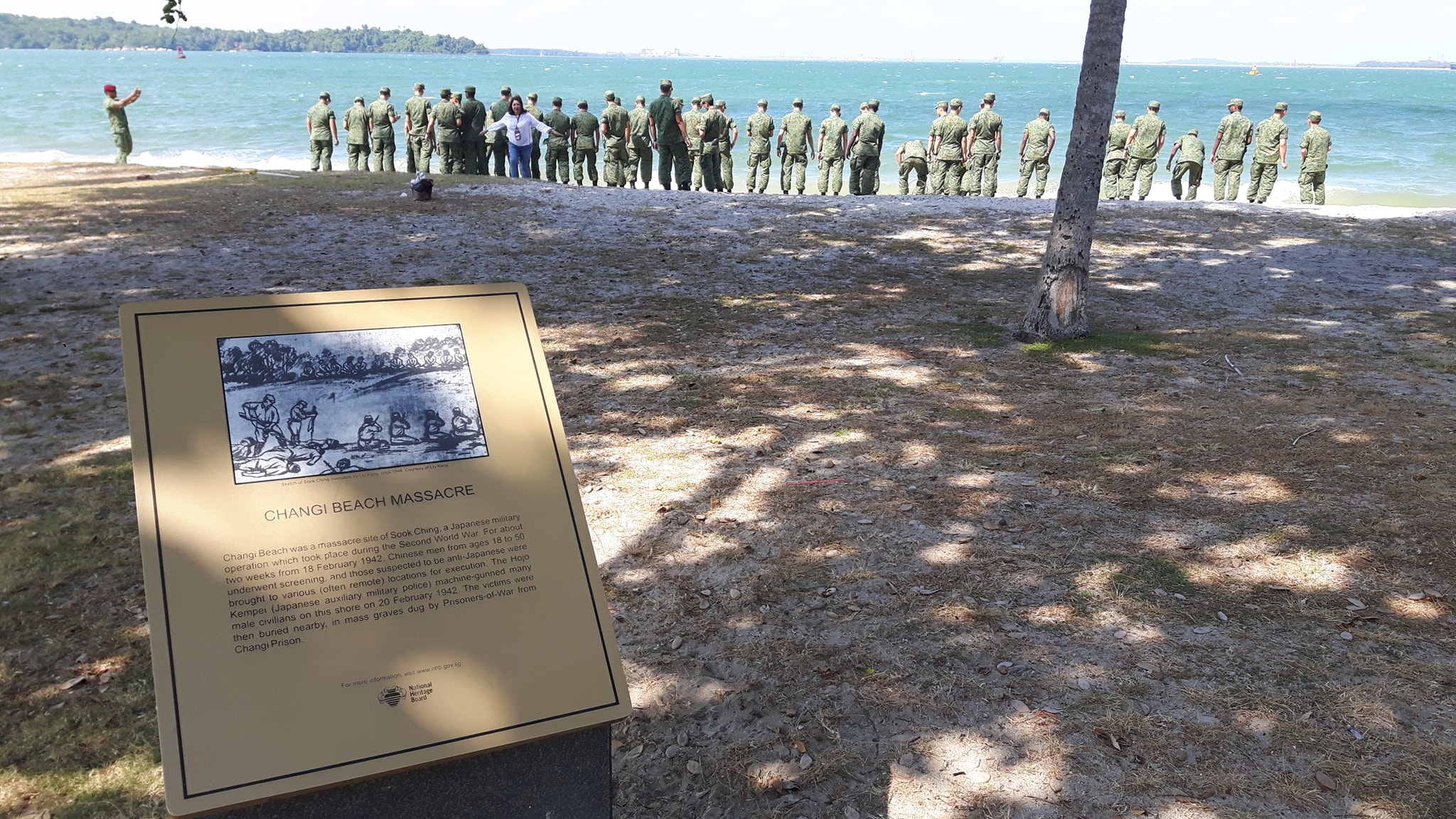Earlier this month, former Foreign Minister George Yeo put up a Facebook post that reflected his concerns about having only English text on a World World II monument that he visited at Changi Beach.
World War II monument at Changi Beach
In the post, a screenshot of an excerpt of a speech he made at this year's Singapore Perspectives conference, Yeo explained the history of the original monument that was first erected in 1992 — a short pillar that explained the 1942 Sook Ching massacre, which claimed the lives of 66 men along the water's edge.
On the surface, seen in this photo, was originally an account of events in all four of Singapore's national languages, as well as Japanese on the front vertical side:
 Photo via Before Midnights
Photo via Before Midnights
Here's a picture of the stone showing the Japanese words as well:
 Photo taken in 2013, from James Tann's Facebook post.
Photo taken in 2013, from James Tann's Facebook post.
But it was later on replaced with a sign that shows only the English account of events.
 Photo taken in February 2019, from Lee Brown's Facebook post.
Photo taken in February 2019, from Lee Brown's Facebook post.
Concerns over cultural dilution
Yeo shared that he was "very dismayed" when he visited the site recently with a friend and saw the unexpected change because, he explains, the monument was deliberately in multiple languages so every Singaporean, and Japanese visitors too, can understand what happened.
English may be a convenient language to serve a broad group of visitors, he acknowledged, but he said he was concerned about how Singapore's culture and identity will be diluted in the process:
"I was so dismayed to find that that monument had been replaced by one which is purely in English. Now, I understand the reasons why it is convenient, whether it's in Changi Airport or whether it is at our museums, to have one language.
This is deliberately reducing our cultural genome because sometimes it creates autoimmune reactions and so on for short-term purposes. It is denying us of a powerful capability, a precious inheritance from the past which in fact will secure our future."
Yeo also used his experience doing work for the Pope at the Vatican as an example to highlight the importance of us embracing multilingualism as an aspect of our uniqueness:
"I go to the Vatican five times a year for meetings of the Council for the Economy. At every meeting, interpreters, earphones. The day the Church stops using earphones and interpretation, it is no longer the Church. The day Singapore decides to reduce its genome so that we become homogenised, that would be a very uninteresting Singapore."
In addition to that, Yeo argued that different languages also serve as an opportunity to connect to and inform visitors from various backgrounds of Singapore's perspective on historical events.
Reducing our multiple languages to just English, he added, can be detrimental to Singapore's DNA in the long run.
"Every link is two-way. What connects is also a method of infiltration. So we have to adjust to all this. The day we decide that it is too tiring to do all this, that day we will shrivel and become inconsequential."
Here's the full text from his speech that Yeo posted on Facebook:
 Image from George Yeo's Facebook post.
Image from George Yeo's Facebook post.
Previously, Yeo also brought other foreign guests to view the monument prior to it being replaced to an English-only plaque, like the Taipei trade representative in 2013:
Monument to carry five languages again
In response to Yeo's feedback, the National Heritage Board (NHB) put up a response on their Facebook page announcing their decision to "refresh the design" of Singapore's World War II markers to carry all five languages.
NHB said they also agree with Yeo's sentiment that having them allows Singaporeans and visitors "to better reflect on how our wartime history has shaped Singapore and its people".
It also said it will continue to strive to engage visitors in various ways to present the content in both meaningful and easy-to-read ways.
Here's the text of the post:'We thank Mr George Yeo for his feedback on the Changi Beach marker. World War II is an important part of Singapore’s history. Given its special significance, we agree with Mr Yeo that having these historic site markers in four official languages and Japanese will enable Singaporeans and visitors to better reflect on how our wartime history has shaped Singapore and its people. NHB will therefore refresh the design of its World War II markers to carry all five languages. NHB aims to strike a balance between presenting content that is meaningful to the reader, and practical considerations such as readability. We will explore ways, including by using technology, to make more information on our historic sites available to visitors.'
Minister for Culture, Community and Youth, Grace Fu, also commented on Facebook on Feb. 22 that she is supportive of the change so that Singaporeans and visitors can better understand World War II as well as the lessons to be learned from this part of Singapore's history.
"I am glad that NHB has reviewed Mr George Yeo’s feedback, and will be updating its World War II historic site markers to include all four official languages and Japanese. This will enable more Singaporeans and overseas visitors to gain a better understanding of our wartime past, as well as the lessons to be learned from this poignant chapter in our history."
Top photo via Lee Brown Facebook post.
If you like what you read, follow us on Facebook, Instagram, Twitter and Telegram to get the latest updates.
